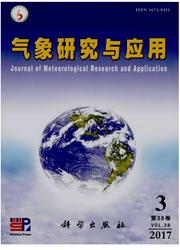

 中文摘要:
中文摘要:
利用EC再分析资料(2.5°×2.5°)、台风年鉴资料及广西降水资料,统计分析了1970—2014年影响广西的台风残涡暴雨过程。采用逐例与合成分析方法,对发生日暴雨≥10站过程与弱降水过程的前24h环流特征进行对比分析。结果显示:(1)1970—2014年的45a中,共有18例台风残涡影响广西,约2—3年出现1次,造成广西日暴雨≥10站的暴雨过程15次.占83%:(2)5—9月均有台风残涡影响广西,其中8月有7例最多,7月有6例次之,9月有3例,5、6月均为1例:(3)依照广西台风影响路径分型,广西台风残涡暴雨共有3类4型,即第Ⅰ、Ⅱ、Ⅲ类强降水型和第Ⅲ类弱降水型;(4)有利台风残涡维持并发生暴雨的环流条件有:200hPa高度场上,台风残涡移入南亚高压东侧强辐散区之下,500hPa高度场上.台风残涡移向高原槽前斜压锋区.台风残涡环流呈倒槽状与季风低压区环流相连,850hPa高度场上,季风急流伴随湿度大值区与台风残涡环流相连接,地面有弱冷空气扩散南下。
 英文摘要:
英文摘要:
Based on the EC reanalysis data (2.5°×2.5°) , typhoon data and precipitation data, the rainstorms of typhoon residual vortexes in Guangxi from 1970 to 2014 are statistically analyzed, and the circulation characteristics during the first 24 hours of the processes with more than 10 rainstorm stations and weak precipitation processes are comparatively analyzed by the method of cases and synthetic analysis. Results show that: (1) From 1970 to 2014, 18 typhoon debris impacted Guangxi, about one renmant vortex every 2-3 years, resulting in 15 rainstorm processes with more than 10 stations whose daily precipitation was above 50ram, accounting for 83%; (2) Every month from May to September, typhoon remnant vortexes impact Guangxi with seven vortexes in August, six in July, three in September and one in May and June separately. (3) According to the track of typhoon, the rainstorms can be divided into 3 classes and 4 types, namely heavy precipitation type of class I ,II ,III, and weak precipitation type of class 111. (4) The favorable circulation for maintaining typhoon remnant vortex and causing rainstorm are: the typhoon remnant vortex moves in the strong divergence area on the east side of South Asia High at 200hPa, at 500hPa, it moves to the baroclinic frontal zone in front of the plateau trough, the residual eddy appears inverted trough-like circulation, connecting with monsoon low pressure circulation, monsoon jet at 850hPa with large relative humidity links with typhoon remnant vortex circulation, and a weak cold air spreads southward on the ground.
 同期刊论文项目
同期刊论文项目
 同项目期刊论文
同项目期刊论文
 期刊信息
期刊信息
